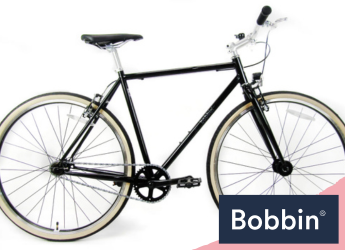What Is a Single-Speed Bike?
Welcome to the world of cycling simplicity and efficiency! If you’re curious about the sleek, minimalist bicycles cruising the streets, you’re in for a treat. Discover the simplicity and appeal of single speed bikes in this post! We’ll explain the basic idea of a single-gear ratio and highlight the benefits. Join us as we guide you through the essentials of these favoured bicycles.
Single Speed Bikes Explained
Single-speed bikes, in their purest form, are bicycles equipped with a single gear ratio. This alone distinguishes them from their multi-speed counterparts. The essence of a single-speed bike lies in its simplicity — no gears to shift, just one fixed gear ratio. This means that as you pedal, the bike moves forward without changing gear settings. The absence of a derailleur simplifies the design. This results in a sleek, minimalist appearance overall.
Explore the range of common single-speed bicycles, including:
The rider’s control over speed and power becomes more direct. It offers a pure and connected cycling experience. On top of their straightforward design, they promise ease of use and riding sensation. Single-speed bikes are perfect for those who want simple and efficient riding.
The Components of a Single-Speed Bike
Single-speed bikes are characterised by their straightforward design. They consist of essential components that contribute to their simplicity. The key components include a single-gear ratio, a chain, a front and rear brake, pedals, and a frame. The single-gear ratio determines how the bike moves forward. The chain transfers pedal power to the wheels, connecting kinetic energy. Front and rear brakes ensure controlled stops, enhancing safety. Pedals support the transfer of energy from the rider to the bike, propelling it forward. Finally, the frame forms the bike’s structural foundation, providing stability and support. Together, these elements create a cohesive and functional single-speed bike.
Notably, what sets single-speed bikes apart is the absence of a derailleur. It’s a notable departure from multi-speed bikes that utilise one to shift between gears. This lack of a derailleur streamlines the bike. It reduces maintenance requirements and creates a cleaner aesthetic, to add. The simplicity of the construction enhances the bike’s reliability and ease of use.
Advantages of Single-Speed Bikes
Riding a single-speed bike comes with a multitude of benefits that appeal to cyclists of all levels. The foremost advantage is simplicity. No complex gear-shifting mechanisms make for an uncomplicated and user-friendly biking experience. This also extends to maintenance. Single speed bikes typically require less upkeep compared to their multi-speed counterparts. The streamlined design reduces the likelihood of mechanical issues, to add.
Beyond practical considerations, single-speed bikes offer a uniquely connected riding experience. With direct control over the sole gear ratio, riders feel more in tune with the bike. This fosters a sense of connection and engagement while cruising through various terrains. Riding a single-speed bike makes biking simpler and brings more joy to the journey.
Challenges and Considerations
Keep in mind that riding a single-speed bike also comes with a few challenges that are worth noting. One potential hurdle is adapting to varied terrains without changing gears. New riders may initially find this challenging, especially on hills or uneven surfaces. Overcoming these demands involves honing specific pedalling techniques and adjusting riding styles.
To ease the transition, consider starting on flatter routes. Then, gradually progressed to more challenging terrain. Additionally, choose an appropriate gear ratio based on the riding environment for comfort. With practice and mindful gear selection, riders can successfully navigate these challenges. Most importantly, to fully enjoy the unique experience that single-speed biking offers.
Riding Techniques
To ride a single-speed bike well, use effective techniques for the best performance. Pay close attention to your pedalling technique. Maintain a steady and efficient cadence to maximise power transfer. On varied terrains, adapt your approach. Stand on the pedals for more power on climbs and switch to seated for smoother surfaces. When tackling hills, adjust your speed and gear ratio beforehand. Experiment with different gear ratios to find what suits your style and the terrain. Embrace a fluid riding style, allowing the bike to move naturally beneath you. With practice, you’ll develop a connection between your pedalling and the bike’s motion. This, in turn, enhances both efficiency and enjoyment during your single-speed rides.
Single-Speed vs. Multi-Speed Bikes
Knowing the differences between the two is important for choosing the one that suits you. As mentioned, single-speed bikes have a fixed gear ratio. This simplifies the riding experience with no gear-shifting options. In contrast, multi-speed bikes offer a range of gears for versatile terrain adaptability. When considering which is right for you, reflect on your riding habits.
Single speed bikes excel in urban environments or on flatter terrains. This offers ease of use and low maintenance. They’re especially perfect for short commutes and riders valuing simplicity. Now, suppose you encounter varied landscapes or plan longer rides with diverse elevations. A multi-speed bike, like the Bobbin Kingfisher, can provide the flexibility needed to tackle different conditions. Tailor your choice to your riding style and environment for a seamless ride!
Round-up
To sum up, if you want a simple and enjoyable biking experience, consider a single-speed bike. Whether for urban commuting or weekend riders, it might be your ideal companion. Enjoy the straightforward designs and pleasure of cycling with this uncomplicated choice!
For a dependable bike shop, Bobbin is the right choice. Explore our varied range, including kids bikes and adult bikes options! Up next on your reading list: What is a Kids’ Hybrid Bike?










